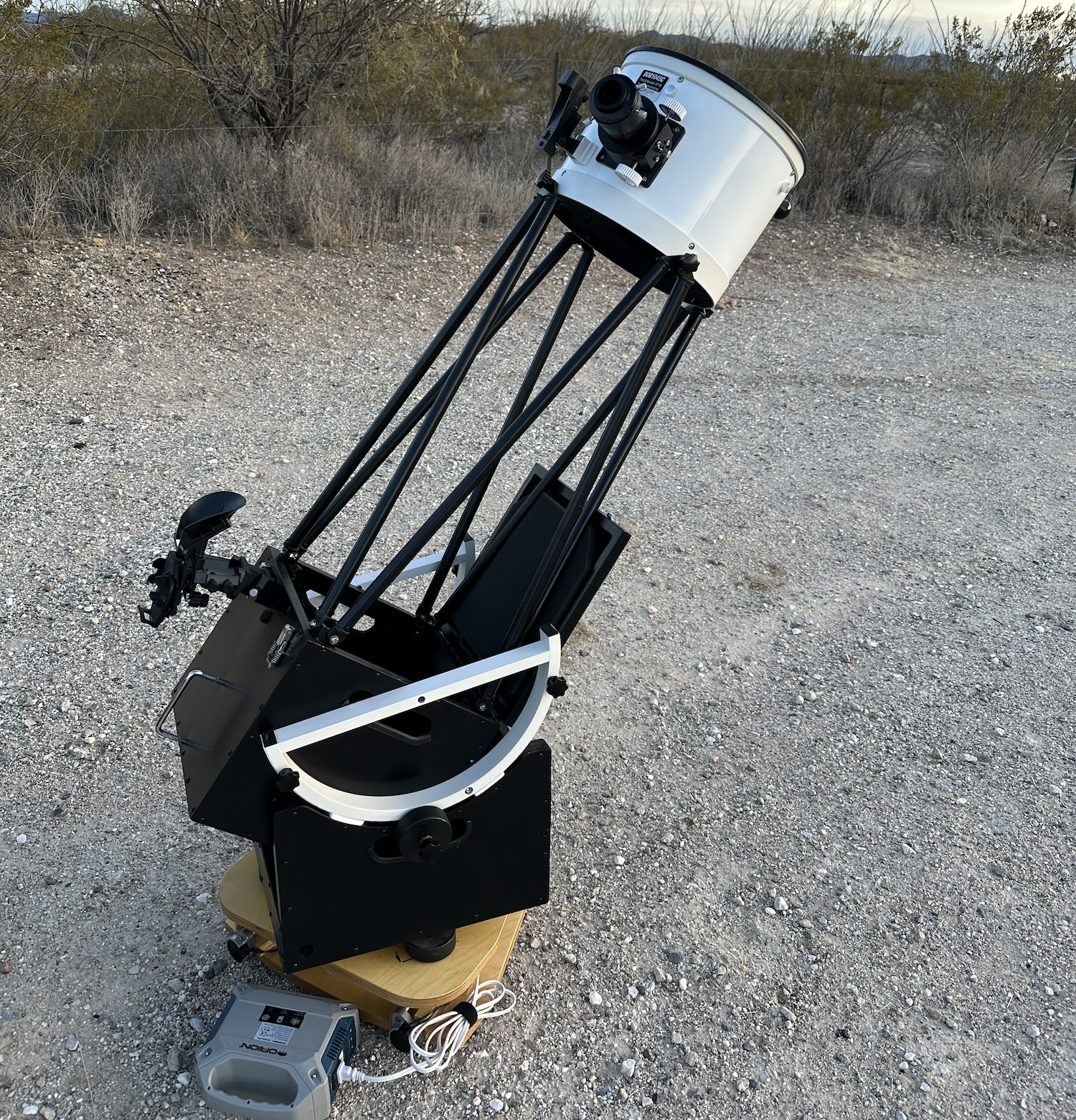The Optical Tube
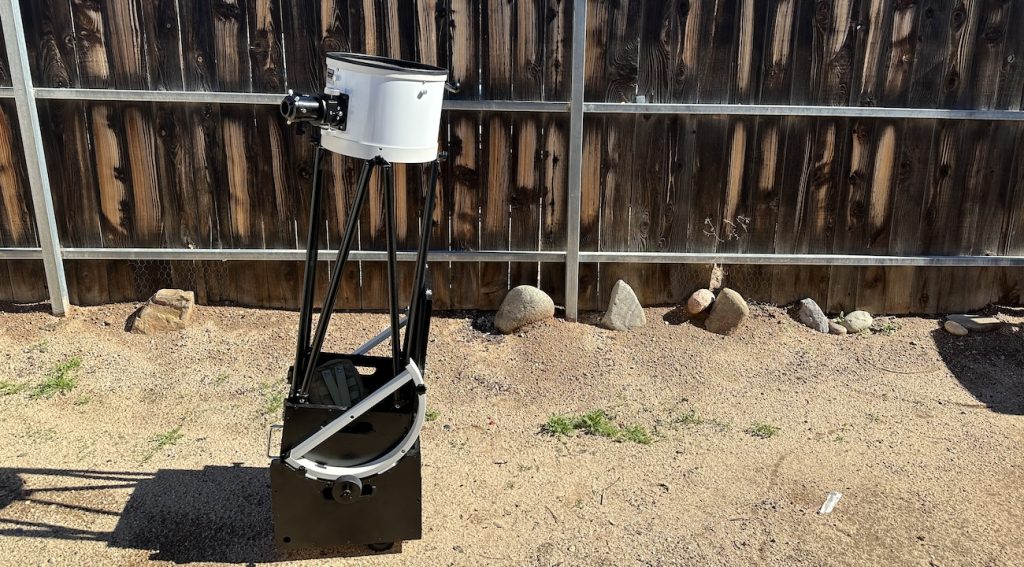
The Explore Scientific 10” Hybrid Truss Tube Dobsonian is a 10” (254mm) aperture Newtonian reflector with a focal ratio of f/5 and focal length of 1270mm.
At f/5, coma is somewhat visible to me at the edges of the field of view when I use the scope with most wide-angle eyepieces of mine, but it’s hardly a major nuisance to me. However, when I use cheap eyepieces with such a faster focal ratio telescope, I experience astigmatism and other issues as well.
The optics in the 10” Hybrid Dobsonian are extremely high quality and I’m certain that it’ll satisfy even the most demanding user who is used to premium optics.
A Slightly Different Collimation Process
Collimation is also very important, but luckily for us, the 10″ Hybrid Dobsonian makes it very easy to do.
To adjust the 10” Hybrid Dobsonian’s primary mirror collimation, I use a long wrench-like tool (which is provided) to adjust three screws on the sides of the primary mirror. This is essentially the inverse of the normal operation, where the primary mirror sits on three spring-loaded knobs at the back. The benefit of this design is that I can adjust the collimation while looking through the focuser with a Cheshire or similar collimation tool. It’s also more rigid and thus, in my experience, it holds collimation better to begin with.
The primary mirror is collimated from the front. The primary mirror is supported in a 6-point floatation cell with rollers rather than being simply glued in or resting against clips. This system supports the primary mirror like a water bed and allows the mirror to deform less under its own weight and thus provide slightly sharper images.
The secondary mirror is mounted on a standard 4-vane spider and I can adjust it for collimation with thumb screws (rather than a hex key, which is often required with mass-manufactured scopes).
No collimation tools are supplied with the 10” Hybrid Dobsonian; check out my collimation guide for more information.
The Fairly High-Quality Focuser
The focuser on the 10” Hybrid Dobsonian is a single-speed 2” Crayford focuser that uses brass compression rings to hold eyepieces. It’s fairly high quality, though I’ve an opinion that a double-speed unit would’ve been nicer.
The biggest issue I’ve found with this focuser is that it’s mounted at a 90-degree angle to the ground—that is, dead horizontal.
As a result, when the telescope’s eyepiece is inserted, it is often not only low but at an uncomfortable angle. A few minutes with a drill and screwdriver allowed me to rotate the upper tube assembly cylinder and fix this problem. But it’s one more issue to worry about, and it’s understandable if you’re worried about drilling holes in your brand-new, shiny, and expensive telescope.
The Introduction to Truss Tube Dobsonian’s Parts
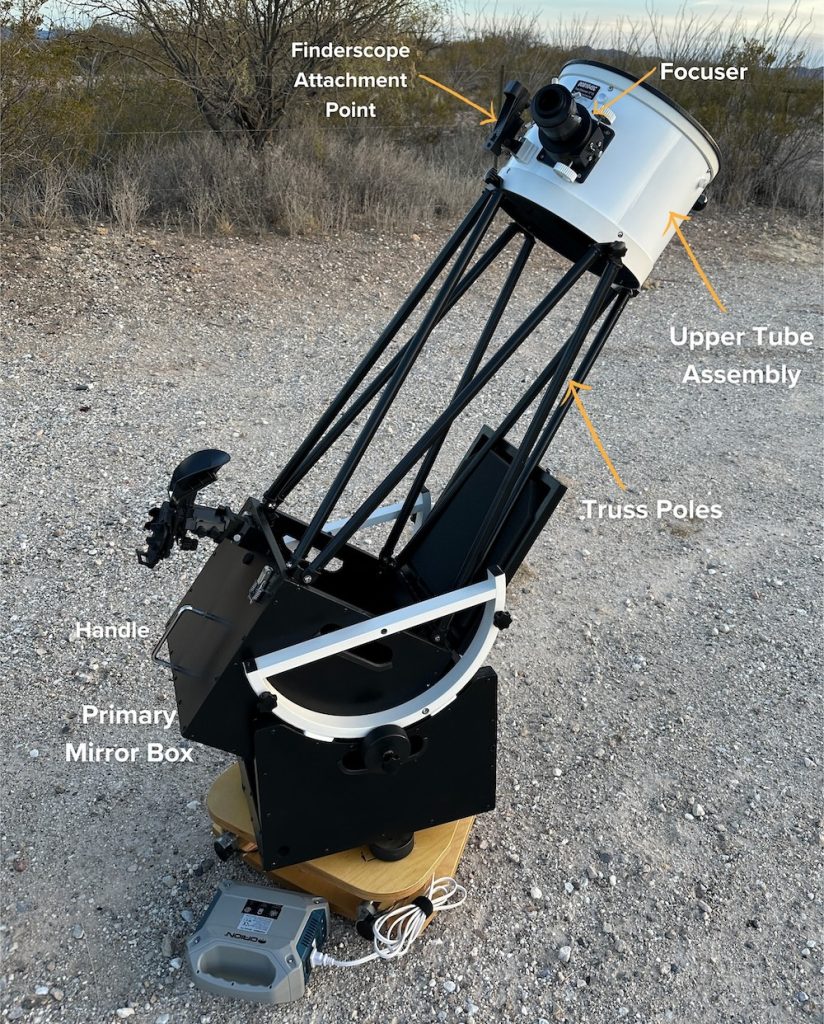
The 10” Hybrid Dobsonian’s tube dismantles into three (or four) parts. The primary mirror box holds the mirror, mirror cell, and has the altitude bearings attached, the latter of which are technically removable but make more sense to leave on. The mirror box has two cut-out handles and an attached handle to make it easy to carry.
Eight truss poles screw onto the corners of the mirror box and mate at the top of the tube, where we attach the upper tube assembly, which contains the focuser, secondary mirror, and attachment points for a finder.
No fans are built in like the more expensive truss tube Dobsonians that Explore Scientific sells, but adding them was easy enough for me. I could add a rear fan without any permanent modifications, and the sheet aluminum making up the mirror box is easy to drill into to add fans on the sides. The top of the mirror box has an integrated cover that flips up during use and latches shut, as you can notice in the above picture.
Shrouds to Keep Stray Light Out
Since the 10″ Hybrid Dobsonian has an open truss tube, it needs a fabric shroud to keep stray light out of the tube and reduce the risk of dew. You can have one custom-made or sew it yourself fairly easily out of a fabric such as Spandex or Lycra, which is stretchy but won’t droop into the light path.
I need to also warn you that the handles on the mirror box can also leak light, so sealing them up with paper or tape would be a good idea.
The Inconsistent Set of Accessories
The Explore Scientific 10” Hybrid Truss Tube Dobsonian doesn’t come with the most consistent set of accessories. This seems to be due to stock issues with Explore Scientific’s supplier, but there could be other reasons that I don’t know of.
You will always, at the minimum, get a red dot finder and a 25mm Plossl eyepiece (51x).
The red dot finder that Explore Scientific provides has a tinted window (seems to me as a relic from it being meant for firearms use originally). What I dislike about it is that it’s hard to turn on and off and doesn’t maintain alignment well. It also uses a non-standard bracket to attach to the tube, so a finder from another company, such as GSO/Apertura or SVBONY, doesn’t fit without an adapter or removing the Explore Scientific bracket and drilling more holes.
I believe replacing the finder with a Rigel Quikfinder or Telrad is probably best to avoid extreme frustration with aiming this telescope.
I consider the provided 25mm, 1.25” Plossl eyepiece to be acceptable at best. It has a recessed eye lens, which means that I practically have to jam my eye into it to look through it. It also has some issues with glare and overall sharpness, particularly on bright targets. The apparent field of view is about 50 degrees, giving me a true field of one degree in the sky (double the angular diameter of the full Moon) with the 10” Hybrid Dobsonian.
Depending on where and when you order the 10” Hybrid Dobsonian, a few other cheap, basic accessories may or may not be included. A 10mm, 1.25″ Plossl eyepiece (127x) with the same design features and flaws as the 25mm is occasionally included. Other than being functional, I don’t have much to say about it.
An extremely low-quality blue-tinted plastic “moon filter” is often thrown in and does little more than blur the image through the eyepiece into a dull, blue-tinted facsimile of its former self. A similarly low-quality and useless all-plastic 2x Barlow is also sometimes provided with the 10” Hybrid; I would recommend throwing it away.
Lastly, Explore Scientific sometimes throws in a basic planetary video camera (meant to be used in conjunction with a 2x or 3x Barlow lens) with the 10” Hybrid, which works fine but is not as good as a more modern and high-quality unit like the 120MC and 224MC offered by ZWO. Also, hand tracking with a Dobsonian can be difficult to do well enough for frustration-free planetary imaging.
Mount
The Explore Scientific 10” Hybrid Truss Tube Dobsonian is of course a Dobsonian and thus pivots on laminate-covered bearings riding on Teflon pads in an alt-azimuth configuration (up-and-down and side-to-side). Instead of the usual particle board, I’ve noticed the whole base is made out of metal.
Rather than using melamine or a “lazy susan” type roller bearing, the azimuth axis of the ES 10” Hybrid is FRP glassboard swiveling on chunky Teflon pads. It’s the same product that is used on premium Dobsonians from companies like Obsession and New Moon Telescopes. The azimuth motions are much less jerky than those of other brands’ Dobsonians because of the use of pebbly FRP and large Teflon pads.
The design of the altitude axis of the 10″ Hybrid Dobsonian is even more unique for its price range.
For smooth motion, most cheap commercial Dobsonians I’ve tried use undersized circular altitude bearings. But this makes such scopes hard to balance because putting in or taking out heavy eyepieces or other accessories makes it top-heavy or bottom-heavy. The only solutions to this design flaw are to constantly adjust the center of gravity by moving the bearings or adding/removing weights, or to add additional friction with clutches or springs and impede otherwise-smooth altitude motions.
The 10” Hybrid, as with the other Explore Scientific Dobsonians, doesn’t suffer from those pesky compromises with altitude motion.
Instead, smooth motion is provided by a huge pair of altitude bearings that are bolted to the sides of the mirror box and covered with the same FRP laminate as the azimuth axes. The bearings are so large that a couple of inches of center-of-gravity shift does not result in the telescope swinging around the sky up and down on its own. This is the same solution that more expensive “premium” Dobsonians use, as well as most homemade scopes, and for good reason. There is a clutch you can use to stop the altitude axis from moving if you need to, but it’s unlikely you’ll ever need to.
Should I buy a Used Explore Scientific 10” Hybrid Dobsonian?
A used Explore Scientific 10” Truss Tube Hybrid Dobsonian is a great scope, though it’s still going to be a bit of a fixer-upper.
Make sure that the mirror coatings are in good condition, that the motions are smooth, and that all metal parts are free of serious damage. While repairable, damage to the mirror box or rocker is annoying to fix, and replacing parts is next to impossible unless you have tools for shaping and working with sheet metal.
Alternative Recommendations
The 10” Hybrid Dobsonian is a great telescope, but if you’re not the type to want to go shopping and make a bunch of modifications straightaway, this might not be the telescope for you. Here are some of our alternative picks at and below its price point.
Under £600
- The Apertura AD8/Zhumell Z8/Orion SkyLine 8 has less aperture than the 10” Hybrid, and its altitude and azimuth bearings are arguably inferior in design for a variety of reasons. However, you get the simplicity of a solid tube, built-in upgrades like a cooling fan and dual-speed 2” Crayford focuser, and comes with provided accessories that are actually fairly high-quality like a pair of eyepieces and a 9×50 right-angle finderscope.
- The Sky-Watcher Virtuoso GTi 150P’s collapsable tube and considerably compact form factor make it a great “grab n’ go” scope (especially when used to supplement a larger 10” or bigger Dob like the Hybrid) and it features full, smartphone-operated motorised tracking and GoTo, with the ability to aim the telescope manually around the sky as you wish with or without using the electronics. A manual version is also available at a lower price as the Heritage 150P for budget-minded audiences or those who simply aren’t interested in the GoTo or tracking functionality. 130mm variants of both models also exist as part of the Virtuoso GTi/Heritage lineup, but we’d recommend the 150mm as it’s a lot better of a performer with a minimal difference in bulk, weight, or cost.
- The Orion SkyQuest XT8’s included features and accessories are similarly as sparse as the 10” Hybrid Dobsonian, though the provided finder and eyepiece are at least usable and upgrading later is easy – plus the spring-tensioned altitude bearings are an upgrade over the ridiculous ball-bearing system of the AD8/Z8 design.
700-£800
- The Apertura AD10/Zhumell Z10/Orion SkyLine 10 offers similar performance to the 10” Hybrid Dobsonian in a simpler solid-tubed package with all the same great features and accessories as the AD8/Z8. The difference in weight or volume from an 8” solid-tubed Dobsonian is negligible, and as such if you can afford the 10” model we’d highly recommend it.
- The Celestron StarSense Explorer 8” Dobsonian’s design and features are largely the same as the cheaper Orion SkyQuest XT8, but with the added feature of Celestron’s StarSense Explorer phone dock and software, which turns your smartphone into a plate-solving navigation tool for easily finding your way around the night sky without any additional motors, power, or hardware. The Dobsonian base has less-than-great motions but does feature cutouts to decrease weight, and the tube has built-in carry handles. A 10” StarSense Explorer Dobsonian model is also available, which we’d recommend if you can afford it.
- The Sky-Watcher 8” FlexTube Dobsonian lacks the true truss system of the 10” Hybrid Dobsonian, but takes up slightly less volume than a regular 8” solid-tubed telescope when collapsed. However, it’s still not particularly compact, the base is quite heavy, the bearings and included accessories are so-so, and the scope still needs a shroud to keep stray light out. Larger FlexTube models are available where the design is a little more effective.
Aftermarket Accessory Recommendations
The 10” Hybrid Dobsonian, of course, needs a shroud. Explore Scientific offers a shroud for their 10” and 12” truss Dobsonians, but it is often out of stock and may not fit the 10” Hybrid. You can sew your own fairly easily, pay anyone with a sewing machine to do it, or have a custom one made at Shrouds by Heather (a truss pole bag is also a good idea if you’re paying for fabric anyway).
Next, we’d recommend a good finder. Our favorite pick in this category is probably the Rigel Quikfinder. It projects a “bulls-eye” dot on the sky and is easy to align with the telescope; plus, it’s lightweight and features a built-in dew shield and pulse mode. A Telrad or QuInsight will also work, but these are bulkier and heavier. A 9×50 unit is also an option, but it requires drilling holes and installing a new bracket. I recommend sticking with a zero-power reflex sight because they are cheaper, easier to use, and faster to install.
For eyepieces, regardless of what you get with the scope, you’re going to want to start with a clean slate. What eyepieces are right for you ultimately depends on your budget and observing goals, but for a typical starter set, we’d recommend the SVBONY 26mm wide-angle (49x), a 15mm wide-angle or redline eyepiece (85x), and a 9mm gold-line or red-line eyepiece (141x).
A shorter focal length eyepiece such as the Astromania 4.5mm (285x) or something else for between 200x-300x is also a good idea if your atmospheric conditions are good enough to regularly support such high magnifications. You could also just get an entire set of gold-line or red-line eyepieces, but having a little more field than the 20mm by going for a longer focal length and 2” barrel is nice for low power, and something with more magnification than the 6mm is arguably better for planets.
Lastly, a 2” UHC (ultra high contrast) nebula filter such as the Orion UltraBlock will greatly improve your views of nebulae through the 10” Hybrid Dobsonian or really any other telescope. You can screw 2” filters onto the Hybrid’s 2” to 1.25” adapter to use with 1.25” eyepieces, and it’s best to future-proof yourself even if you have no plans to obtain or use any 2” eyepieces right away.
What can you see with Explore Scientific 10″ Hybrid Dob?
Solar System objects aren’t really affected by light pollution, though a steady sky is required to view them in fine detail. The 10” Hybrid Dobsonian does a fantastic job with a high-magnification eyepiece and good-seeing conditions. The phases of Mercury and Venus are easy to see; the polar ice caps and dust storms on Mars are also present. When Mars is in its closest proximity to Earth, I could sometimes see a few dark markings during very good-sighting conditions with the 10” Hybrid.
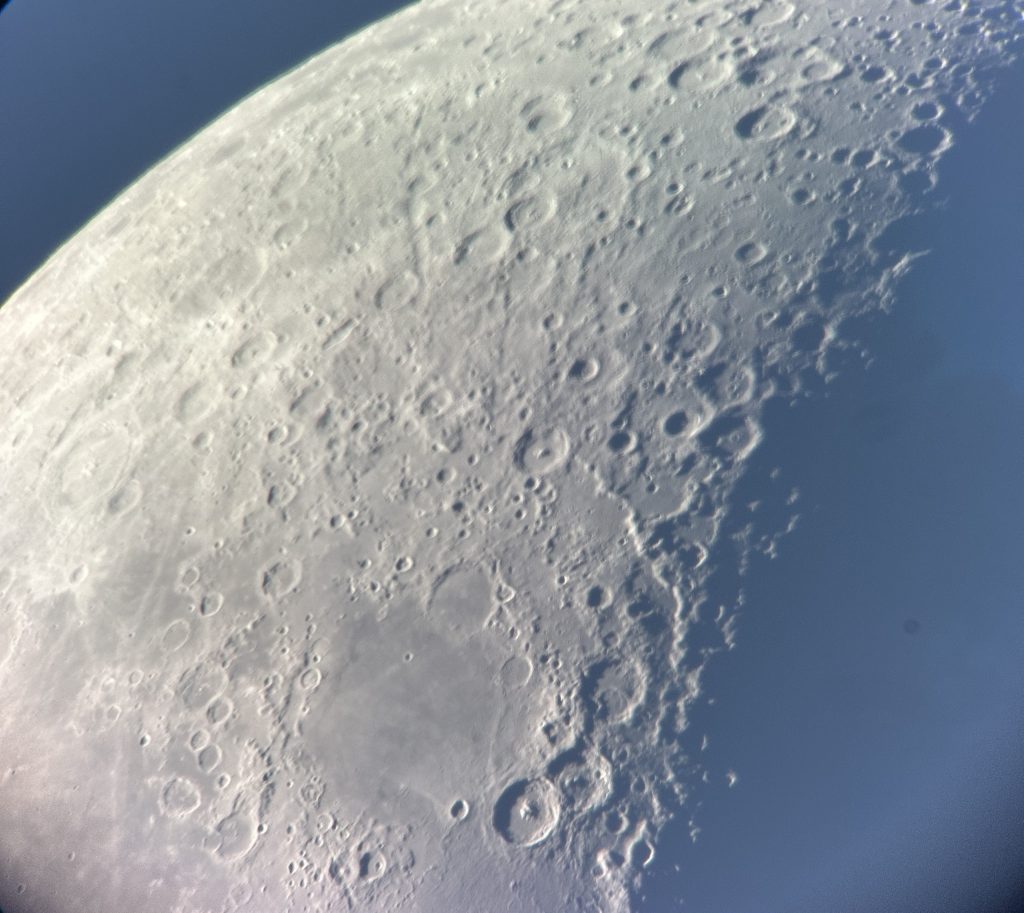
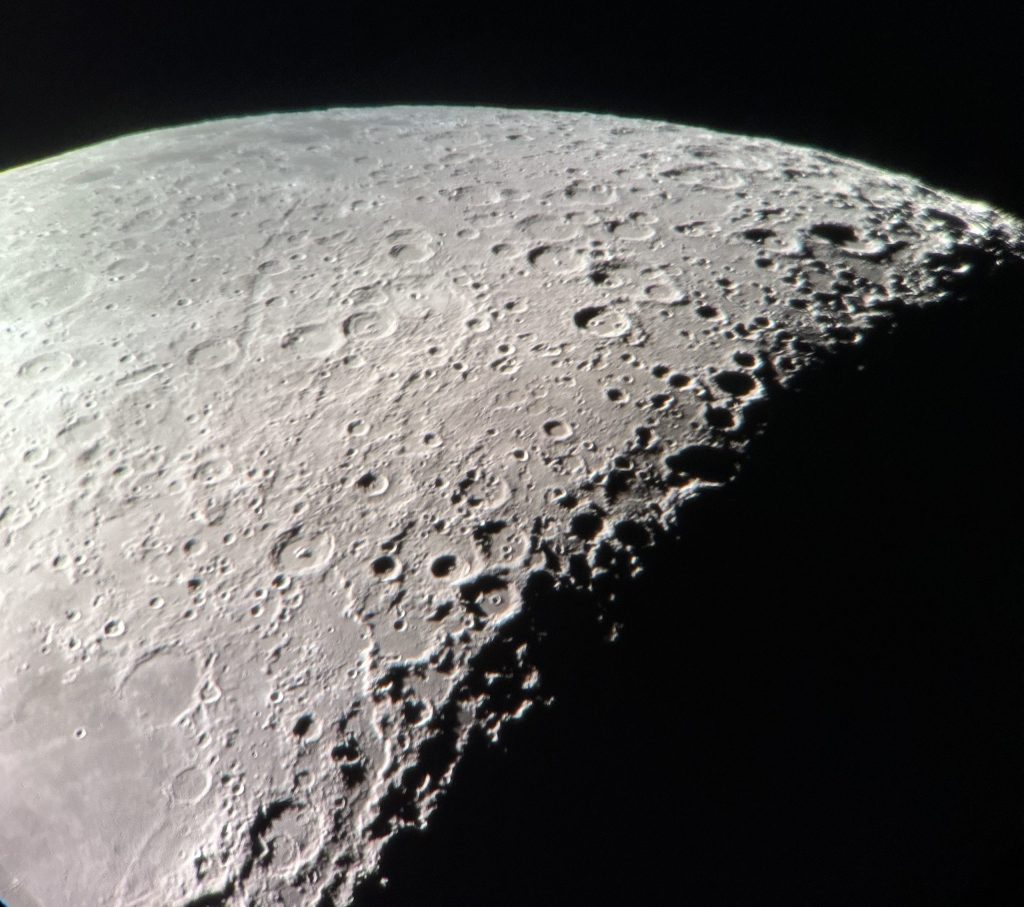
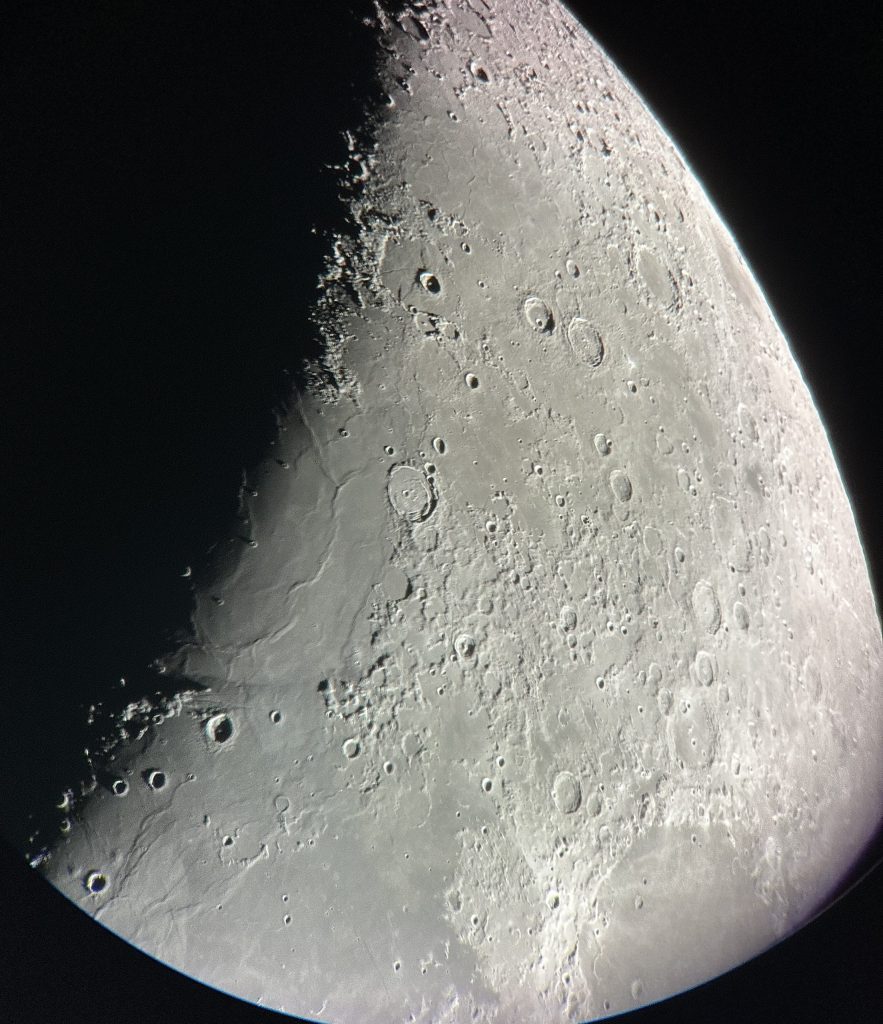
The Moon shows countless craters, ridges, mountains, and other geological details. It’s simply jaw-dropping at any phase and at any magnification.
The 10” Hybrid Dobsonian shows me Jupiter’s moons even at low power; high power reveals their disks when they transit in front of Jupiter, along with their shadows following closely behind. Jupiter itself shows a variety of constantly changing and colourful cloud belts, storms, and festoons. The Great Red Spot can also be seen, though it often blends in with the cloud belts and is constantly getting smaller and smaller as time goes by.
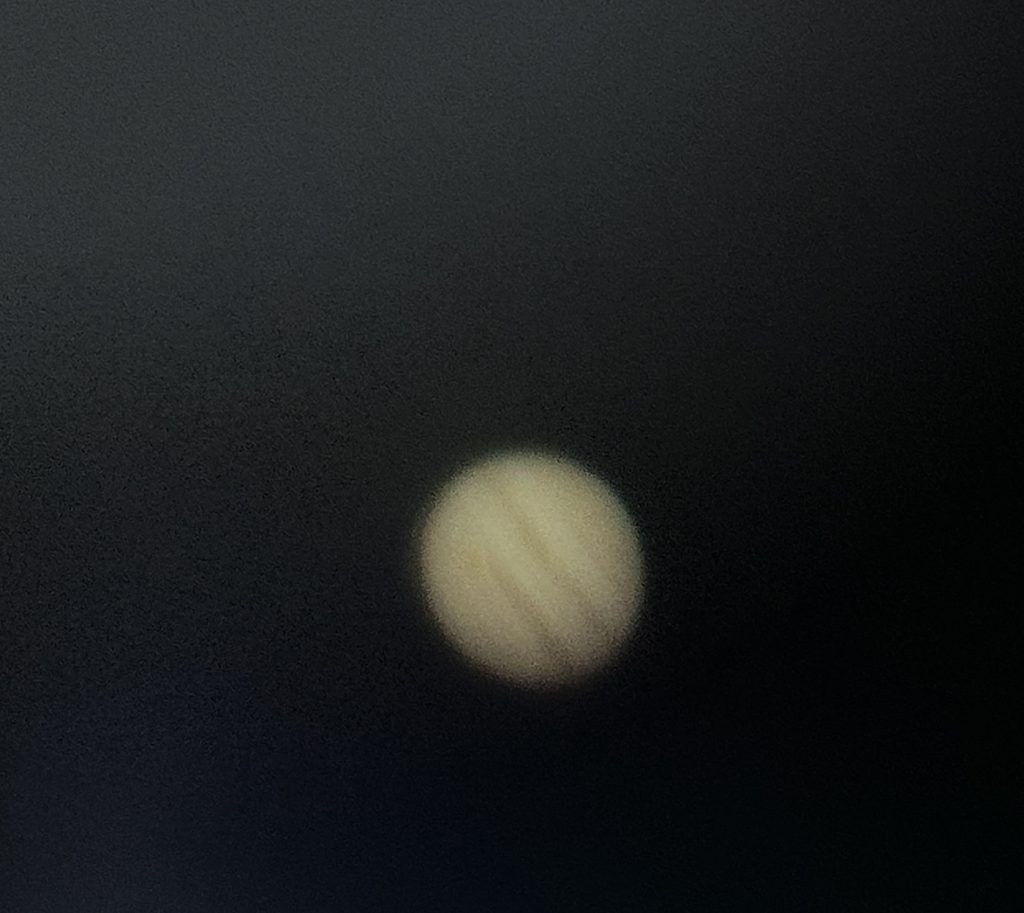
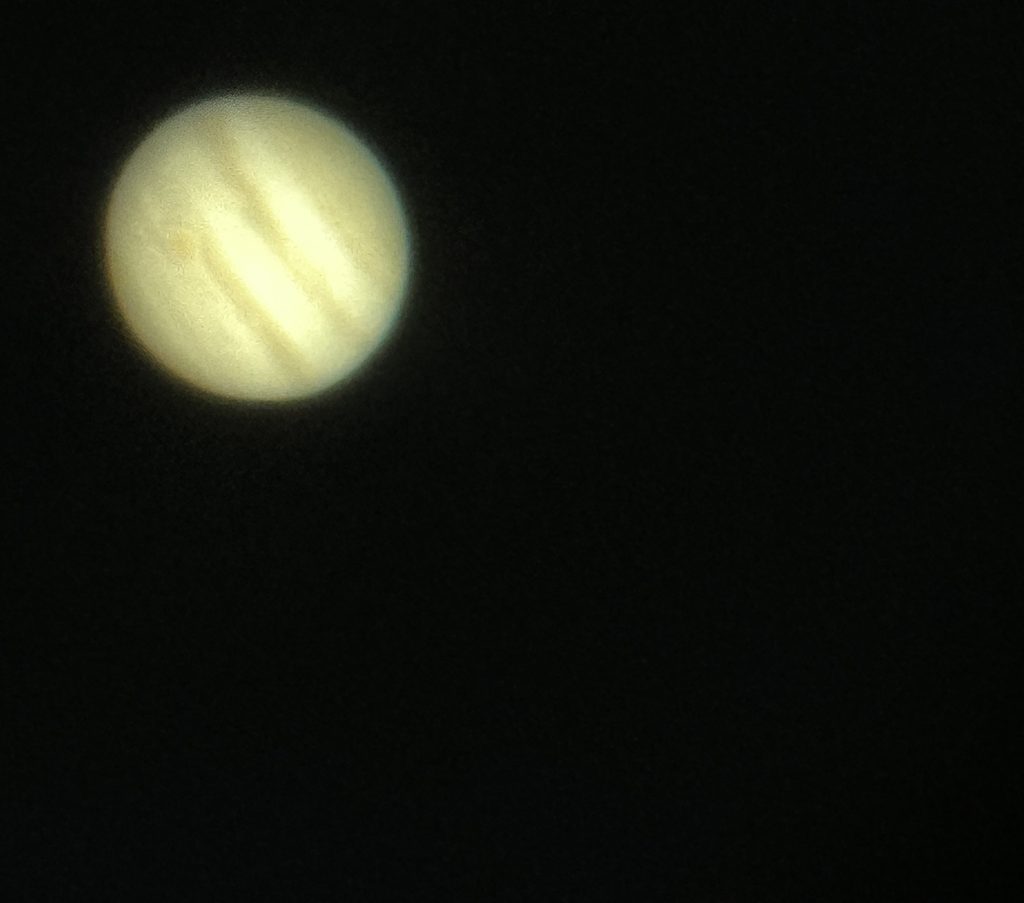
Saturn’s rings are seen easily as well, and the 10” Hybrid Dobsonian resolves the Cassini Division—a gap in the rings—during moments of good seeing, along with a handful of moons and the cloud belts on Saturn itself.
I could also resolve the disk of Uranus and perhaps even its moons and faint wisps of detail in its clouds under exceptional conditions and with high magnification. Neptune and its moon, Triton, can be seen, though resolving Neptune’s disk clearly is a challenge. And of course, faint Pluto is just barely within the grasp of the 10 Hybrid Dobsonian’s light-collecting abilities and can be faintly seen as a star-like point under dark skies.

What you can see, at least outside the Solar System, with the Explore Scientific 10” Hybrid Truss Tube Dobsonian depends on our light pollution conditions. Even under light-polluted skies, there’s plenty to see in some objects.
Globular star clusters resolve well enough to show individual stars at 100x magnification or above with the 10” Hybrid Dobsonian and show their different shapes and structures. Some, such as M15, have very compact cores; some, like M13, have dust lanes; and others, like M92, are visibly flattened on one axis and shaped like ellipses.
The Explore Scientific 10” Hybrid also shows thousands of open star clusters; brighter ones like M11, M35, or the Double Cluster show beautiful and bold colours in their brighter stellar members in a way with which a smaller scope simply cannot compete.
With a 2” wide-angle eyepiece, I could enjoy panning the rich star fields of Auriga, Cassiopeia, Cygnus, Scutum, and Sagittarius and make out faint dark nebulae and various clusters interspersed within the glow of the Milky Way. The smooth motions of the 10” Hybrid Dobsonian’s mount make panning around while looking through the eyepiece an absolutely pleasurable experience.
Nebulae and galaxies are more affected by light pollution than point sources like star clusters, though I could still see details in bright objects with the 10” Hybrid Dobsonian under city or suburban skies, like the brilliant Orion Nebula or Andromeda Galaxy. Under dark skies, however, I can see thousands of galaxies with the 10” Hybrid, and many brighter ones show dust lanes and other features, such as the looping dust lanes, star-forming regions, and orbiting companion galaxies of M31, the dramatic dust lane of M64, the dust lanes and varying morphology of all three members of the Leo Triplet, the perpendicular filaments of M82, and the ubiquitous sombrero appearance of M104. The spiral arms of M51, M33, and M101 also begin to show up under dark skies, and you can see hundreds of galaxies in the ubiquitous Virgo Cluster, often dozens at a time in a single field of view.

The 10” Hybrid Dobsonian does best on nebulae when you insert a UHC filter and get to some dark skies. The Orion Nebula (M42) looks visibly greenish unfiltered and reveals the Trapezium Cluster at its center; a UHC brings out the faint “wings” and looping gas at the outer extremities of the nebula. The Lagoon Nebula (M8) dazzles, and the Trifid (M20) shows its dark lanes. The Swan Nebula (M17) resembles its namesake, and the Helix Nebula reveals itself when you pop in a filter, albeit faintly. The Veil Nebula looks gorgeous with good skies and a UHC filter, revealing eye-popping detail that extends for several degrees in either direction.
Small planetary nebulae look best under dark skies but can be seen under most viewing conditions with the 10” Hybrid Dobsonian, revealing bluish or greenish colours along with fine detail at high magnifications during moments of good seeing. Examples of these include the Ring, Cat’s Eye, and Blinking Planetary nebulae.

